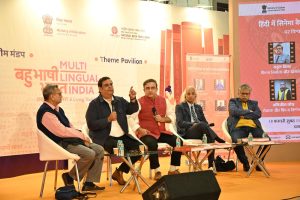
Although Sriram Tamrakar couldn’t witness its inauguration, his enduring work now serves cinema enthusiasts. Unlike its predecessors with 250 and 500 entries, this cinema encyclopedia features over 1,250 introductions of artists, musicians, directors, and technicians associated with Hindi cinema. It also offers insights into Indian film institutions’ formation and activities, along with a list of national award-winning films, establishing itself as an authoritative source on Hindi cinema.
Renowned filmmaker Rahul Mitra, known for his successful ventures such as Saheb Biwi Aur Gangster, Saheb Biwi Aur Gangster Returns, and Torbaaz, delved into a comprehensive analysis of societal shifts over the past decade, alongside an exploration of recent works by emerging filmmakers. He emphasised its significance for both cinema enthusiasts and students, affirming its potential to serve as an invaluable resource. He asserted the essence of cinematic storytelling, and reiterated the fundamental dichotomy of films: they are either good or bad. He stressed the importance of emotionally engaging the audience through a blend of factual accuracy and narrative depth, underscoring that the newly unveiled encyclopedia serves as a harmonious fusion of both elements.
Anurag Punetha delved into the societal changes witnessed over the past decade and the evolving landscape of cinema, particularly with the emergence of new filmmakers. Avijit Ghosh commended the meticulous research and factual presentation evident in the encyclopedia. Highlighting the importance of documenting the growth of cinema with evidence, he emphasised the historical significance of this endeavour.
Senior film critic Arnab Banerjee hailed the arrival of the encyclopedia as a significant milestone in Hindi cinema literature, resonating with the profound affection of the Indian audience towards Hindi films. Film historian and filmmaker Rajeev Srivastava, who played a key role in the creation of the encyclopedia, said that the publication presents an authenticated account of the entire history of Hindi films up to the year 2018. This landmark event marks a significant stride in preserving and celebrating Hindi cinema’s rich heritage, ensuring accessibility for future cinephiles and scholars.





